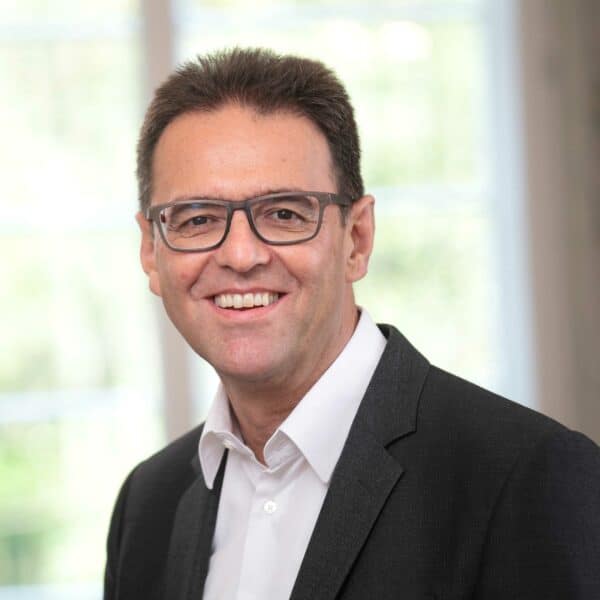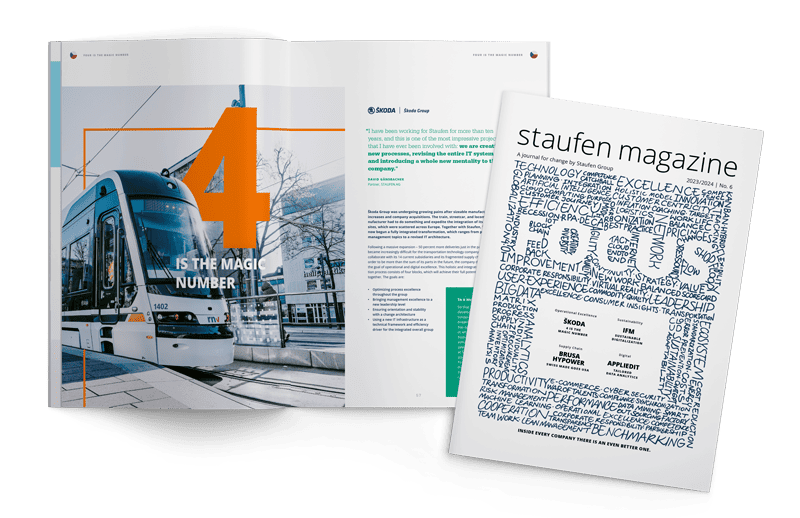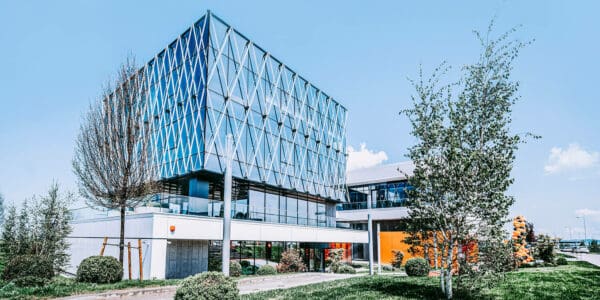
“Only if the remaining greenhouse gas emissions of our products are offset by climate protection certificates, we will get the contract extension in 2025.”
This statement by the managing director of a medium-sized automotive supplier clearly shows that sustainability is now business-critical (see also the Staufen study “Future Industry”). This is primarily due to the new reporting requirements. According to the EU directive “Corporate Sustainability Reporting Directive” (CSRD), which came into force at the beginning of 2023, around 15,000 companies with 250 or more employees in Germany will have to include additional information on sustainability and CO2 in their annual reports. In the case of manufacturing companies, it can already affect companies with fewer employees if the balance-sheet total exceeds EUR 20 million and net sales exceed EUR 40 million.
Customers, investors, labor market – sustainability pressure from all sides
Sustainability is not trivial. With the amendment of the Climate Protection Act, the federal government has tightened the requirements. The goal is greenhouse gas neutrality in Germany by 2045. By 2030, emissions must have been reduced by 65 percent compared to 1990. No company can avoid this, even if it initially avoids the reporting obligation. In any case, it is not enough to simply deliver some numbers. In order to achieve the sustainability goals, the topic must become an elementary part of the corporate strategy and lead to concrete measures. This starts with energy management to reduce unnecessary emissions and goes all the way to the circular economy to make the entire product life cycle sustainable.
The pressure on the companies comes from four sides: Firstly, many large customers are demanding more sustainability from their partners, since the emissions from supplies and preliminary products will be taken into account in their CO2 balance. In the near future, it will be difficult to obtain supplier contracts without verifiable eco-success. Second, the company’s financing is becoming more difficult. Institutional investors and traditional financial institutions are paying more attention to environmental aspects. In the recent past, professional investors have occasionally refused to discharge board members because they showed too little commitment to sustainability. Thirdly, customers now also expect sustainable products. This applies primarily to the consumer market. But also B2B customers want to keep their own CO2 balance low. Added to this is public pressure from NGOs and the media. In the worst case, high sales losses and a tarnished reputation are the result. Fourth, the younger generation in particular pays attention to sustainability when choosing an employer. It is quite possible that a company without measurable ecological and social activities will soon have difficulties in winning over the sought-after talents in the competitive job market.
Software instead of a tally sheet – data as the basis of a green strategy
By now at the latest, every owner or managing director should be aware that the statutory sustainability reports are only a minimum requirement. Because they merely state the status quo. Those who do nothing will report very similar figures a year later. Nevertheless, they are a basis for any sustainability strategy. Who wants to avoid CO2, will have to analyze their emissions regularly. The prerequisite for reporting is sufficient digitization of the company so that the relevant data can be easily brought together in a database – i.e. not manually using a tally sheet.
In addition, there are now numerous software solutions for the CSRD reports that import all the necessary data and process them in accordance with the requirements of the EU standards. In smaller companies, the foundations for data analysis often have to be laid first. Larger companies often already have all the necessary data, but first have to bring it together centrally.
Quick wins: reduce operating costs and CO2 emissions in lockstep
But then in order to be able to report a significant CO2 reduction in the following year, really sustainable measures are necessary, in both senses of the word. To reassure everyone responsible: Even small steps are important, all measures for a CO2 reduction or avoidance as well as better product cycles make sense. However, this only applies to a limited extent for CO2 certificates. They are more of an interim solution for emissions that have unfortunately been unavoidable up to now.
So instead of relying exclusively on certificates, companies should rather develop a strategy for reducing emissions from the outset. It is not only allowed, but even sensible to pick the low-hanging fruit first. Quick initial successes can be achieved, for example, by taking measures to reduce electricity and heat consumption. At the same time, these are quite impressive cost-cutting programs. An example: The construction of a solar system on the roof of a hall reduces the tax burden through depreciation and the ongoing energy costs through self-use. Supplemented by further power-saving measures and modern, smart energy management, the operating costs can be reduced to a similar extent as the CO2 entry of the company.
Decarbonize the whole value-added chain
Such measures are included in Scopes 1 and 2 of the CO2 footprint of a company. Scope 1 includes the direct release of greenhouse gases, for example through combustion processes or your own power plant. Scope 2 is the indirect release from energy suppliers. Both of these areas of application are relatively easy to address and yield good results, even in the short term. Scope 3 is more demanding. This scope includes upstream and downstream greenhouse gas emissions along the entire value-added chain. They are more difficult to measure and account for, because hardly any company knows all the processes in its environment.
Scope 3 requires significant changes in the use of precursor products and in disposal. Additionally, there are things like business trips or the commuting habits of employees. Ultimately, companies have to check all processes and also hold their employers responsible. Also here, there are initially simple measures: helpful is, for example, replacing business trips with conference calls in management and doing remote VR connections for maintenance technicians or an internal support program for an e-company fleet that also charges in the company parking lot. The companies must check in each process at where the avoidable CO2 occurs, and then react accordingly.
Target: Green innovation leadership
These are also more of a quick win, because major interventions in the value-added chain require staying power and innovative spirit. Many companies are now pursuing circular economy approaches. In this model, products should be shared, leased, reused, repaired, refurbished and recycled for as long as possible. In this way, their life cycle is extended. In order to enter the circular economy, sustainability must be integrated directly into the design and construction of products. Ultimately, a company has economic advantages from it. This has not yet arrived in all companies. Sustainability is too often perceived as a cost factor. The opposite is true: companies can increase their market importance by presenting themselves as pioneers and innovation leaders in the field of sustainability – without greenwashing!
From analysis to green transformation
The first step to becoming a net-zero company is to calculate your current CO2 footprint. Staufen customers will be able to draw on the expertise of Fokus Zukunft in the future. Since 2016, the Starnberg sustainability consultancy has already accompanied 1,800 companies on their way to sustainability. “We are pleased to be a key partner in Staufen AG’s goGREEN approach in the future. The cooperation is based on common values such as long-term customer relationships at eye level,” says Axel Banoth, Managing Director of Fokus Zukunft.
Based on the current emissions, Staufen and Fokus Zukunft identify suitable levers to reduce the CO2 emissions together with their customers. In the implementation of the Green Transformation, the Staufen consultants will help with the proven hands-on mentality. “The experts of both houses are bundling their collected knowledge so that our customers are both green and lean in future”, says Staufen-consultant Peter Trick.

Peter Trick
Senior Partner

Request the English Magazine now as a digital or print version

YOU MIGHT ALSO BE INTERESTED IN

Lean, Digital, Green: A pioneer out of conviction
Whether lean processes, digitization or now sustainability: The foam specialist Ebco is always one of the pioneers. After the medium-sized company determined its CO2 footprint, production and products are now becoming more sustainable step by step.
Read more
Sustainable digitalization
The sensor technology specialist ifm has built a new factory in Sibiu, Romania, in which production is not only flexible, but also very energy efficient. Everything has been considered in the green factory: from the use of green concrete to an active foundation for temperature control to sustainable power supply. This makes the green factory an example for the entire ifm group.
Read more
Go Green – an opportunity for long-term competitiveness
Heat records, forest fires, dried-up rivers and lakes – climate change caused by greenhouse gas (GHG) emissions can no longer be ignored. In Germany, industry is responsible for around one-fifth of GHG emissions.
Read more





